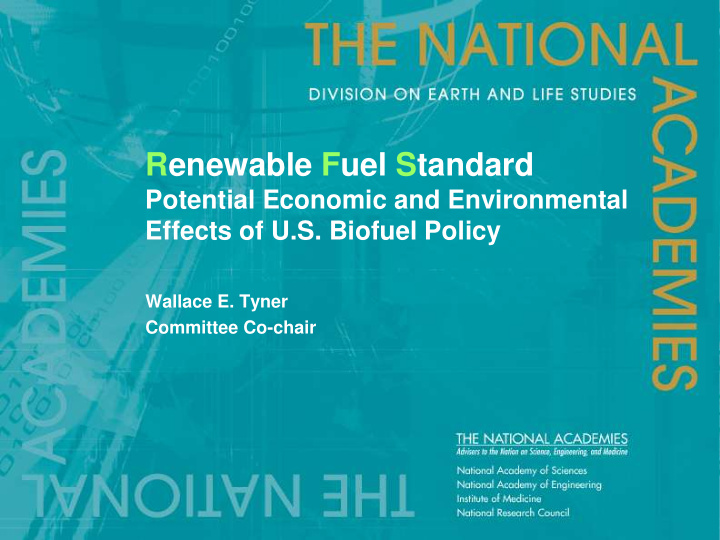



Renewable Fuel Standard Potential Economic and Environmental Effects of U.S. Biofuel Policy Wallace E. Tyner Committee Co-chair
Study Committee Members Stephen J. McGovern — Chemical Lester B. Lave 1 ( Chair )--Economics Engineer Ingrid C. Burke ( Cochair ) 2 --Ecology John A. Miranowski — Agricultural Wallace E. Tyner ( Cochair ) 2 --Energy Economics Economics Aristides Patrinos — Renewable Virginia H. Dale — Landscape Fuel Production Ecology Jerald L. Schnoor 3 — Water Quality Kathleen E. Halvorsen — Natural David B. Schweikhardt — Trade Resource Sociology Jason D. Hill — Life-cycle Analyses Theresa L. Selfa — Rural Sociology Stephen R. Kaffka — Agronomy Brent L. Sohngen — Forest Economics Kirk C. Klasing — Animal Nutrition J. Andres Soria — Conversion Technologies 1 Member of the Institute of Medicine, Deceased May 9, 2011 2 Cochair from May 9, 2011 3 Member of the National Academy of Engineering
Renewable Fuel Volume Consumption Mandated by RFS2 40 Cellulosic biofuels Total = 36 35 Advanced biofuels Billions of Gallons Biomass-based diesel 30 Conventional biofuels 16 25 20 4 1 15 10 15 5 0 Year Source: Energy Independence and Security Act of 2007
Finding: RFS2 cellulosic fuel mandate unlikely to be met in 2022 • No commercially viable biorefineries exist, to date, for converting lignocellulosic biomass to fuels. • Aggressive deployment, in which the capacity build rate doubles the historic capacity build rate of corn- grain ethanol, necessary to produce 16 billion gallons of cellulosic biofuels by 2022. • Policy uncertainties could deter investors from aggressive deployment.
Finding: Only in an economic environment characterized by high oil prices, technological breakthroughs, and a high implicit or actual carbon price would biofuels be cost- competitive with petroleum-based fuels. • Biofuel Breakeven Model used to estimate: o The minimum price that biomass suppliers would be willing to accept for a dry ton of biomass delivered to the biorefinery gate. o The maximum price that processors would be willing to pay to at least break even.
Gap between supplier’s price and processor’s price is negative for all types of cellulosic biomass likely to be produced in 2022. Price Gap Between Biomass Suppliers and Processors Supplier’s Processor’s Cellulosic Feedstock Price Gap Price Gap Price Price (Per Dry Ton) (Gallon of Ethanol) Corn Stover in $92 $25 $67 $0.96 Corn-Soybean Rotation Alfalfa $118 $26 $1.31 $92 Switchgrass in the $133 $26 $106 $1.51 Midwest Short Rotation Woody $89 $24 $65 $0.93 Crops Forest Residues $78 $24 $54 $0.77 Source: Examples from committee analysis in BioBreak model. Price of Oil $111/barrel. Biomass yield 70 gallons of ethanol per dry ton.
• Price gap for cellulosic feedstock could be closed under other market circumstances: – Price of oil reaches $191 per barrel. – A price is placed on carbon that makes cellulosic biofuels more cost-competitive. – Government subsidy payments increase to cover price gap. – Government biofuel mandates are enforced.
Economic Effects of Increasing Biofuel Production • Land prices will increase because of increased demand for food and feedstock production. • Food -based biofuel is one of many factors that has contributed to upward price pressure on agricultural commodities, food, and livestock feed. • Competition with existing markets will increase wood product prices if woody biomass contributes heavily to biofuel feedstock.
Economic Effects of Increasing Biofuel Production • Changes in trade in agricultural commodities have so far been buffeted by the decline in the value of the U.S. dollar. • Imports of wood products will likely increase, imports of oil will decrease slightly, and exports of livestock products will decrease slightly. • Federal budget outlays would increase because of spending on subsidy payments, grants, loans, and loan guarantees and because of foregone revenue from biofuel tax credits.
Barriers to Achieving RFS2 • High cost of producing cellulosic biofuels compared to petroleum-based fuels. • Uncertainties related to market conditions and government support programs (for example, EPA waiver). • Blend wall and transportation infrastructure if large amount of biofuels for meeting RFS2 is be met by ethanol. • Other environmental and social barriers.
Thank you. Report is available online at www.nap.edu.
Recommend
More recommend